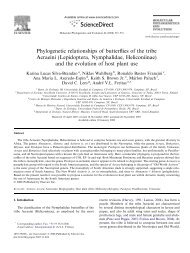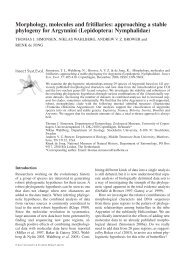The life history and ecology of Melitaea diamina (Nymphalidae) in ...
The life history and ecology of Melitaea diamina (Nymphalidae) in ...
The life history and ecology of Melitaea diamina (Nymphalidae) in ...
You also want an ePaper? Increase the reach of your titles
YUMPU automatically turns print PDFs into web optimized ePapers that Google loves.
June <strong>and</strong> K sambucifolia flowers <strong>in</strong> July. A further eight species <strong>of</strong><br />
flower were used occasionally (Table l), but the majority <strong>of</strong> flower<br />
species on the meadows were unused. I observed males feed<strong>in</strong>g on<br />
moist soil occasionally.<br />
M. <strong>diam<strong>in</strong>a</strong> is a fairly sedentary species, especially females. Of all<br />
females captured <strong>and</strong> marked (n = 285), only 6% were recaptured <strong>in</strong><br />
a different meadow. Several females were recaptured repeatedly <strong>in</strong> the<br />
same small area <strong>of</strong> one meadow. Males are relatively more mobile,<br />
possibly as a consequence <strong>of</strong> their mate-search<strong>in</strong>g tactic (see above).<br />
Of the 557 males captured <strong>and</strong> marked, 18% were recaptured <strong>in</strong> another<br />
meadow dur<strong>in</strong>g their <strong>life</strong>time.<br />
Discussion<br />
Females actively feed<strong>in</strong>g on K sambucifolia flowers did not exhibit<br />
any <strong>in</strong>terest <strong>in</strong> oviposit<strong>in</strong>g on the same plants. <strong>The</strong> observation that<br />
females lay eggs on non-flower<strong>in</strong>g host plants appears to be connected<br />
to the phenology <strong>of</strong> the larval host plants. K sambucifolia is a perennial<br />
plant (Aalto, 1980), but I observed that flower<strong>in</strong>g host plants senesced<br />
already at the beg<strong>in</strong>n<strong>in</strong>g <strong>of</strong> August, when most larvae were <strong>in</strong> their<br />
2nd <strong>in</strong>star. Thus there is strong selection on females to lay eggs on nonflower<strong>in</strong>g<br />
host plants. <strong>The</strong> mechanism that females use to differentiate<br />
between flower<strong>in</strong>g <strong>and</strong> non-flower<strong>in</strong>g plants is probably visual, though<br />
this has not been studied.<br />
Knowledge <strong>of</strong> the <strong>ecology</strong> <strong>and</strong> <strong>life</strong> histories <strong>of</strong> endangered species is<br />
necessary for their successful conservation. This study shows that only<br />
meadows conta<strong>in</strong><strong>in</strong>g K sambucifolia are suitable habitat for M. <strong>diam<strong>in</strong>a</strong><br />
<strong>in</strong> F<strong>in</strong>l<strong>and</strong>. I found that the butterfly is relatively sedentary <strong>and</strong><br />
thus needs a dense network <strong>of</strong> habitat patches, which are usually small,<br />
for its metapopulation to persist. <strong>The</strong> decl<strong>in</strong>e <strong>in</strong> the number <strong>of</strong> populations<br />
<strong>in</strong> F<strong>in</strong>l<strong>and</strong> dur<strong>in</strong>g the last few decades can largely be attributed<br />
to meadows becom<strong>in</strong>g unsuitable <strong>and</strong> the suitable meadows becom<strong>in</strong>g<br />
more isolated from each other. This is apparent <strong>in</strong> the Tampere region,<br />
where I found six isolated populations (Wahlberg et al., 1996). <strong>The</strong>se<br />
populations are probably remnants <strong>of</strong> a network <strong>of</strong> meadows, <strong>in</strong> which<br />
the other meadows have already become overgrown. <strong>The</strong> overgrowth<br />
<strong>of</strong> the meadows by willows is the most important threat to M. <strong>diam<strong>in</strong>a</strong><br />
at present.





